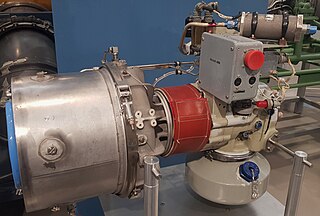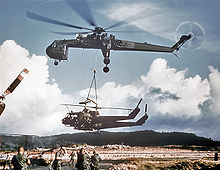
The Sikorsky CH-37 Mojave is an American large heavy-lift helicopter of the 1950s. This design was a late 20th century military heavy lift helicopter. It was the Sikorsky S-56 and entered service as the HR2S-1 Deuce with USMC in 1956, and the U.S. Army as the H-37A that same year as the H-37A Mojave. In the early 1960s the designation was standardized to CH-37 for both, with the HR2S-1 becoming the CH-37C specifically.

The Hughes OH-6 Cayuse is a single-engine light helicopter designed and produced by the American aerospace company Hughes Helicopters. Its formal name is derived from the Cayuse people, while its "Loach" nickname is derived from Light Observation Helicopter (LOH) program under which it was procured, and likely the word "chopper", a common nickname for helicopters.

The CH-53 Sea Stallion is an American family of heavy-lift transport helicopters designed and built by the American manufacturer Sikorsky Aircraft. The Sea Stallion was originally developed in response to a request from the United States Navy's Bureau of Naval Weapons made in March 1962 for a replacement for the Sikorsky CH-37 Mojave helicopters flown by the United States Marine Corps (USMC).

The Mil V-12, given the project number Izdeliye 65, is a prototype helicopter designed in the Soviet Union and the largest helicopter ever built. The designation "Mi-12" would have been the designation for the production helicopter and did not apply to V-12 prototypes.

The Sikorsky H-34 is an American piston-engined military helicopter originally designed by Sikorsky as an anti-submarine warfare (ASW) aircraft for the United States Navy. It has seen extended use when adapted to turbine power by the British licensee as the Westland Wessex and Sikorsky as the later S-58T. This type had a variety of names depending on the role and timing, but included the aforementioned Wessex, Seahorse, Seabat, and Choctaw. Most of the H-34 (S-58) used radial aviation engines, though other powerplants were employed, and the Wessex used predominantly twin gas turbines. Individual versions often had unique names, the type including everything from the U.S. Coast Guard HH-34F Seahorse was used for search and rescue, to the commercial Winnebago Heli-Home, to Canada's CH-126, the USMC it often went by "HUS" after its original designation in that service.

The Hughes XH-17 "Flying Crane" was the first helicopter project for the helicopter division of Hughes Aircraft Company. The XH-17, which had a two-bladed main rotor system with a diameter of 134 feet, still holds the world record for flying with the largest rotor system. It was capable of flying at a gross weight of more than 50,000 pounds (23,000 kg), but proved too inefficient and cumbersome to be mass-produced beyond the prototype unit.

The Sikorsky S-64 Skycrane is an American twin-engine heavy-lift helicopter. It is the civil version of the United States Army's CH-54 Tarhe. It is currently produced as the S-64 Aircrane by Erickson Inc.

A tip jet is a jet nozzle at the tip of some helicopter rotor blades, used to spin the rotor, much like a Catherine wheel firework. Tip jets replace the normal shaft drive and have the advantage of placing no torque on the airframe, thus not requiring the presence of a tail rotor. Some simple monocopters are composed of nothing but a single blade with a tip rocket.

A helicopter is a type of rotorcraft in which lift and thrust are supplied by horizontally spinning rotors. This allows the helicopter to take off and land vertically, to hover, and to fly forward, backward and laterally. These attributes allow helicopters to be used in congested or isolated areas where fixed-wing aircraft and many forms of short take-off and landing (STOL) or short take-off and vertical landing (STOVL) aircraft cannot perform without a runway.

The Sikorsky X2 is an experimental high-speed compound helicopter with coaxial rotors, developed by Sikorsky Aircraft, that made its first flight in 2008 and was officially retired in 2011.

An aerial crane or flying crane is a helicopter used to lift heavy or awkward loads. As aerial cranes, helicopters carry loads connected to long cables or slings in order to place heavy equipment when other methods are not available or economically feasible, or when the job must be accomplished in remote or inaccessible areas, such as the tops of tall buildings or the top of a hill or mountain, far from the nearest road. Helicopters were first used as aerial cranes in the 1950s, but it was not until the 1960s that their popularity in construction and other industries began to catch on. The most consistent use of helicopters as aerial cranes is in the logging industry to lift large trees out of rugged terrain where vehicles are not able to reach, or where environmental concerns prohibit roadbuilding. These operations are referred to as longline because of the long, single sling line used to carry the load.

The Westland Westminster was a British helicopter of the 1950s from Westland Aircraft. A large cargo design, it was powered by two turboshaft engines driving a single, five-bladed rotor. Initially unclad, the all-metal airframe was later enclosed in a fabric covering. Designed and built as a private venture without government assistance, it was cancelled when Westland took over rival helicopter producers and their more advanced projects.

The Sikorsky S-60 helicopter, a prototype "flying crane", was derived from the S-56 in 1958. Proving to be underpowered, the development of the S-60 led to the larger, turbine-engined Sikorsky CH-54 Tarhe military transport helicopter, and its civil S-64 Skycrane variant, which were already on the drawing board by the time the sole example of the S-60 crashed on 3 April 1961.

The Pratt & Whitney T73 is a turboshaft engine. Based on the JT12A, the T73 powered the Sikorsky CH-54 Tarhe and its civil counterpart Sikorsky S-64 Skycrane flying crane heavy-lift helicopters. Turboshaft versions for naval use are known as the FT12.
Sky crane or skycrane may refer to:

The Solar T62 Titan is an American gas turbine engine used mainly as a aircraft auxiliary power unit (APU), conventional power generator, turboprop engine for fixed-wing aircraft or turboshaft engine for helicopters. A new turbine version was developed as the Solar T66.
The Omega BS-12 was a utility helicopter with high ground clearance designed to carry loads behind the cabin at, or near, the center of gravity. It was one of the early twin engine designs to be developed, and had a unique pod-and-boom style design similar to the later Sikorsky S-60

A modular aircraft or pod plane is a design principle for an aircraft where the payload carrying section can be routinely detached from, and reattached to, the rest of the aircraft. It can be compared to the function of intermodal shipping containers.
The Sikorsky S-73 was a proposed aircraft design to meet the United States Army requirement in 1970 for a Heavy Lift Helicopter (HLH) capable of carrying 45,000 lb, a lifting capacity more than twice that of Sikorsky's most powerful helicopter at that time.






















